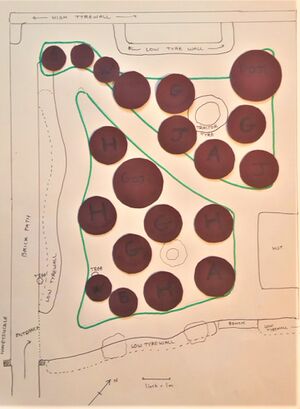
Nature's world was an eco visitor attraction in Middlesbrough, UK. It had various themed gardens and educational features, and closed to the public in 2013. Parts of the site are now managed by a volunteer group. The site also hosts the offices of Middlesbrough Environment City (see: https://menvcity.org.uk/). General aims of the volunteer group are a balance between stewardship of habitat to promote wildlife diversity, and restoration of original form of the gardens. The gardens are open to the public on specific days for education and leisure events.
The former Tyre Garden[edit | edit source]
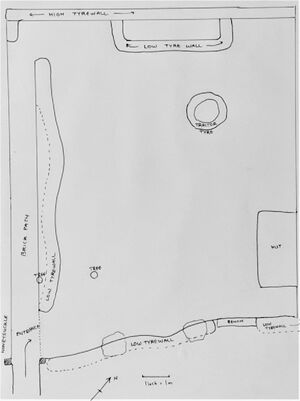
One of the many themed gardens, the Tyre Garden was presumably to demonstrate recycled utility of car tyres in gardening.
SOIL: appears to have moderate clay content, but does not show impeded drainage and waterlogging. Fertility is assumed to be high given the wild growth and several years without cultivation.
ASPECT: flat.
LAYOUT: rectangular with long axis orientated NW - SE. Area is approximately 11 * 9 meters. The edges of the plot are mainly lined by low tyre walls of 3 courses (collapsed in places), often covered by ivy. The NW edge is a collapsing wooden fence, beyond which mature trees (mainly sycamore) with thick undergrowth (mainly wild blackberry). The NE edge is a low tyre wall with a hedge and beyond that apple trees which were once in a cordon. The SE edge is a low tyre wall with medium sized trees and shrubs. The SW edge is a low tyre wall with medium sized trees and shrubs, beyond which a brick path (mostly buried). The layout of original paths and beds has been lost and access to the site was difficult. Hundreds of used tyres which previously may have delineated beds and paths were half buried under soil and vegetation.
SHADE: most areas of the plot are in some degree of shade given trees are present on all sides. The ground next to the SW and SE edges is most shaded. The open ground in the centre of the plot receives more sun, especially towards the N of the plot around the region of the tractor tyre, as well as the N ends of the NW and NE edges.
SPECIES: The tyre garden had become markedly overgrown and it is assumed many of the original plantings had disappeared. "Weeds" such as wild blackberry, stinging nettle, etc. predominated. Limited knowledge prevented identification of many plants, but buddleia, elder, lemon balm, sedum could be identified. Opportunistic trees such as ash and hazel had self seeded and the site was beginning to undergo succession towards woodland. Many bird species and squirrels are present.
Project goals[edit | edit source]
- Repurpose the former Tyre Garden site
- Provide an educational example of how the forest gardening concept can be deployed in garden-sized plots.
- Reorganise tyres on the site as they are known to release harmful substances (e.g. lead) into the soil over time, and are unsuitable for safe food production.
- Create permanently mulched paths for easy access for harvest and maintenance.
- Create a space which is ultra low maintenance in line with limited availability of volunteer time.
- Provide food for humans and wildlife (birds, small mammals, etc.), and attract foraging bees.
Forest gardening is a sustainable form of agriculture without many of the problems associated with industrial agriculture. As such, it is not the intention to completely destroy habitat but rather replace it with artificial habitat that is more useful to humans, while not being too disruptive to surrounding wildlife.
Design[edit | edit source]
Tyres[edit | edit source]
Tyres are often cited as useful recycled containers to grow food, particularly potatoes. They are dark, an added benefit in the UK climate as this increases heat absorption from sunlight, boosting the temperature of the soil within. However, the extent by which contaminants (notably lead and microplastics) from used tyres leach out into surrounding soil, and how these harmful and potentially carcinogenic substances might be concentrated up food chains is not fully understood. In the opinion of the author, enough is now known that the practice of growing food in tyres should be done with caution.
Consequently, the decision to remove tyres from the majority of the plot was made. On the other hand, the complete removal of so many tyres form the site was not easily achievable, tyres have already been present for many years, and recycling is also an important consideration. As a compromise, most of the tyres are to be used in a high tyre wall on the NW edge of the plot, and to add to other tyre walls already present. These tyre walls can provide growing space for plants which will not produce food for humans (e.g. foxgloves, lavender). Where new tyre walls are to be created, they will be underlaid with natural fibre carpet to delay contact with the soil. Most tyres were car tyres of varying sizes. The largest tyres can be used in the lower courses to increase wall stability, and metal wire interwoven to tie it all together. Unwanted bricks, rubble, wood and leaf litter can be used as filler inside the tyre walls (also removing the problem of having to find a use for these materials). In the process of levelling the paths and beds, some soil is also available to place in the top course of tyres to provide immediate growing space.
There is a very large tyre (approx. 1m diameter) which forms a raised bed containing no identified useful plants. Originally a woody perennial grew here, but it is now dead and cannot be identified. The tyre is painted white, which may reduce heat absorption to the bed. It is too large to easily move and so was left. A good plant for this raised bed would be lavender. It will not provide food for humans, but will have a pleasant scent and act as forage for bees. The shrub does not get too high, and so will not overshadow surrounding plants too much, as it is already an elevated position.
Paths[edit | edit source]

In permaculture, it is suggested that paths and beds be laid out to maximize growing space and minimize wasted space on access paths. This "keyhole" arrangement mimics tissues found in organisms and is optimized for surface area for transport across membranes. However, the tyre walls themselves act as growing space will need to be accessible and so a perimeter main path of 1 m width was chosen. Paths are created as follows. Most "Weeds" are removed by hand for composting. The ground is roughly levelled. Natural fibre carpet is laid down. Wood chip mulch is laid on top. This mulch is made from conifers and is unsuitable to place on beds directly but it will be suitable for paths. It is anticipated that these paths will not require any maintenance for several years. Another major path of 1m width could also divide the site, running roughly East-West, providing maximum sun to the south side of the more northern bed.
Beds[edit | edit source]
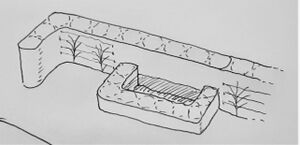
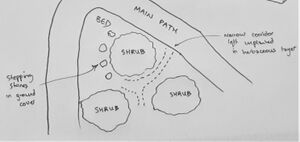
There will be 1 raised bed built into the NW tyre wall. This will likely contain something like Jerusalem Artichoke which would otherwise disrupt other plants. This raised bed will also brace the tyre wall. There is another small raised bed formed by the large tractor tyre.
The layout of the main paths will divide the site into 2 large beds. Beds will be constructed as follows. All large "weeds" will be removed by hand for composting. The beds should not be walked on too much during this time, to prevent soil compaction, particularly during wet weather. Instead, a plank of wood could be used to walk over the beds during construction. Initially these beds will be sheet mulched with carpet to kill off the root systems of perennial "weeds". During this time, shrubs could be planted via holes cut in the carpet. In time, the carpet could be removed to allow groundcover to be planted, or alternatively further holes could be cut in the carpet to allow other plants to be introduced with minimal need for future weeding. Where carpet is to remain, it would be visually better to place a woodchip mulch on top. Unfortunately the only woodchip mulch currently available is mainly from conifers and as such will likely be too acidic to be used on beds.
In the finished beds, it is planned that people should easily be able to walk around each bush without difficulty. Ways to facilitate this are to leave narrow mulched areas unplanted around each bush, or use flat paving as "stepping stones".
Tree Layer[edit | edit source]
Normally in forest gardening, several layers or strata are utilised. It is a common observance in mature forest gardens that they have been too densely planted and the productivity and diversity of subcanopy layers declines significantly over time.
This plot is already shaded by surrounding trees and space is fairly limited. As such, it is likely that only 1 or maximum 2 trees of small to medium size could be included without becoming too shaded in the future. Most of the site will therefore have fruiting shrubs with no tree layer above. Consequences of this will be increased light availability and continued productivity of the shrub layer, herbaceous perennials and groundcover layers. Furthermore, this will provide a much quicker maturation time from planting to first yields. It is also anticipated that this design approach will be a more useful demonstration to visitors, most of whom will only own gardens of a similar size.
The exact choice of tree(s) has yet to be finalized. Considerations include: size (not too big), provide food not already present in the wider Nature's World site (e.g. another apple tree is not really needed), and respond well to being "high pruned" to create space for shrubs underneath.
- 5 cobnuts/hazels of unknown cultivar (approx. 2-3 yrs old) are available for planting, however it is highly likely that any nuts will be taken by squirrels as no measures are in place to prevent this. Therefore hazels will not be planted in the tyre garden plot and could be used elsewhere.
- 2 young trees are already present near the entrance of the site. There was no consensus to remove them, so they have had all branches below 2m removed (this was requested to prevent eye injury). It was suggested that the trunks could be used to train climbers up. One compromise to limit the growth of these trees which will otherwise create significant shade would be to prune and train them to arch together into an archway.
- A small Elder is attempting to cohabit a tyre with the buddleia.
Shrub Layer[edit | edit source]
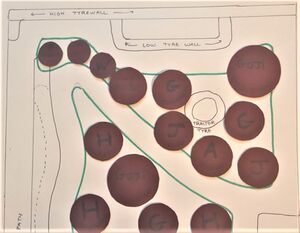
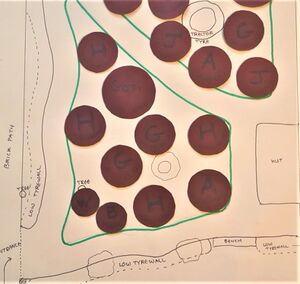
Bush Fruit[edit | edit source]
Some of the shrubs available are thorny. Ideally these will be planted in the centre of beds and not directly adjacent to main paths. Otherwise shrubs are to be laid out in terms of shade tolerance. Where possible they should not be placed immediately next to each other to lessen susceptibility to pests and disease. Shrubs available for planting:
Ribes spp.:
- Gooseberry (3 different cultivars inc. "Hino Red" + "Hino green", approx 2 yrs old)
- Ribes divaricatum (approx 2 yrs old)
- Blackcurrant (approx 3 yrs old)
- Redcurrant (approx 3 yrs old)
- Whitecurrant (approx 1 yr old)
Other shrubs:
- Honeyberry (3 of cultivar "kamtschatica" approx 2 yrs old, a few more to be donated of unknown cultivar)
- Blueberry ("Elliot")
- × Sorbaronia mitschurinii/Aronia melanocarpa (2 of unknown cultivar, approx 2 yrs old)
- Gojiberry (1 or more available, <1yr old)
Desired shrubs yet to be acquired:
- Jostaberry (similar shade tolerance to other Ribes, heterosis + thornless)
- Saltbush (to provide variety as most other harvests will be berries and culinary herbs)
Cane Fruit[edit | edit source]
There are various options with cane fruit. The most productive would be to train them in a post and wire system, or against a wall. Another approach is not to train them and to allow them to grow more freely beneath and around bush fruits. The raspberries are perhaps unsuitable to be used like this because they will quickly take over beds. Finally some of these could be trained up the trunks of trees as a vertical layer. Currently it is planned to train most of these against the NW tyrewall to use this otherwise wasted surface. This surface should get a bit of sun due to the adjacent path, and heat will radiate back from the tyres creating a microclimate. Several Rubus spp. and hybrid berries are available for planting:
- Blackberry (cultivar - "Thornfree", 1 established, 2 others <1yr old)
- Tayberry (1, approx 2 yrs old)
- Loganberry (1, approx 2 yrs old)
- Raspberry (1 "Autumn Bliss" + 1 "All Gold", approx 2 yrs old)
- Japanese Wineberry (1, 1 yr old)
Groundcover & Herbaceous Layers[edit | edit source]
- Rubus tricolor is available for planting and has been observed to be successful in another forest garden in the UK, however it does not seem to fruit too well in this climate. The groundcover is said to be invasive in online sources, however this was not observed in the other forest garden site, despite lack of any risome barrier or permanent paths to contain it. In this forest garden site, it will be entirely surrounded by a 1m diameter permanent path and is unlikely to cause problems in the wider site (unless birds eat the fruit and seed the plant elsewhere in their droppings). It is anticipated that this plant may "swallow" the lower branches of shrubs, and lead them to take on a taller growth habit. However, this is not entirely bad as it will make harvesting the shrubs easier on the back, and hide some of the crop from birds. R. tricolor seems to be able to tolerate the limited amount of foot traffic that will occur when the shrubs are accessed for harvesting and pruning etc.
- Strawberry - this would vigorously cover beds, and may benefit from rhizome barriers to limit its spread.
- Alpine Strawberry - less tendency to spread.
- Jerusalem Artichoke is available. However again it is not suitable to be allowed to freely grow as it will be quite vigorous and try to take over the area it is planted. As such, one ideal location for the Jerusalem Artichokes is in the raised bed build into the NW tyre wall. This will also minimize disruption to other plants when the chokes are to be dug up.
- Asparagus - 2 available for planting, approx. 2 yrs old.
- Culinary Herbs - already present is Lemon balm. Only perennial herbs should be added to minimize maintenance. Mint could be introduced (possibly in its own bed to prevent spread). Others such as rosemary, sage, thyme can also be planted in a warm spot. Fennel is available also.
- Rhubarb.
Non edible plants available are:
- Foxgloves (several)
- Lavender
- Sunflowers
- Nasturtium
Yet to be acquired:
- Wild garlic (Allium ursinum)
- Globe artichoke
Vertical Layer[edit | edit source]
- Honeysuckle is already present in the site and cuttings could be propagated
- As mentioned above, some Rubus spp. could be trained vertically up trunks
- Kiwi (Actinida arguta "issai") is available but is potentially a poor choice because it is not a hardy Kiwi and will be unlikely to produce outside of a greenhouse.
Costs[edit | edit source]
Labour is on a volunteer basis. Most plants are to be donated. Many materials are sourced from pre-existing on site resources (e.g. woodchip mulch). Unwanted carpets were recycled. Total financial costs are mostly on a few plants that were not to hand, and a few other materials such as wire.
Next steps[edit | edit source]
- finish construction of NW tyre wall with raised bed.
- Finish creating paths.
- place carpet as sheet mulch over beds, cut holes in it to directly plant shrubs.
- Last phase once perennial weeds have been eliminated from beds by carpet, would be to remove carpet or cut further holes in it to plant groundcover and herbaceous perennials.
Summer 2021 Update[edit | edit source]
Government policy regarding the SARS COV-2 outbreak meant that for most of a year no work was possible on the site. Before closure, the situation was as follows:
- Sheet mulching: only about 50% had been completed.
- Shrub layer: bed 2 had been fully planted, and 3 shrubs had been planted in bed 1. Note: final layout of shrubs varied from initial plans..
- Tyre wall: the NW tyre wall and raised bed were stacked in place, but were not filled with earth.
- Tree layer: in the end, a single fruit tree was planted, in the centre of bed 2. Since there was ready availability of several other fruit trees on the wider site, a plum tree was selected ("Tsar"). Sadly, it was pot-bound, and was tall and top-heavy. A stake was therefore used, angled at 45% to avoid damaging the roots. The hazels were planted outside the garden.
Upon lifting of relevant Government restrictions, access was permitted to the garden from April 2021. The situation was as follows:
- Despite lack of human intervention, those plants which had been planted had survived the winter, and were budding. The only shrub which did not seem to be thriving was the blueberry. It had been planted on the edge of a gravely, wet area (near to the tracker tyre in Bed 1). It was later moved to a new spot to see if this would help it.
- Those areas which had not yet been sheet mulched were again filled with rampant growth, meaning some of the site had to be cleared again.
- Existing sheet mulch was generally working well. A few unwanted plants, particularly stinging nettles and some wild blackberries, had managed to work their way through the previously laid sheet mulch. The importance of overlapping during sheet mulching cannot be stressed enough.
Work carried out since re-opening:
- Due to lack of available materials, sheet mulching was completed with a combination of old carpet, cardboard, and even decaying sheets of plywood. The sheet mulch was patched up in places where necessary with cardboard and more woodchip.
- A decision to demarcate the beds was made since it was unclear to visitors where the paths were located. Decaying posts and beams were repurposed for this. They may also provide habitat for insects.
- earth was excavated from the neighbouring composting area and used to fill the tyre wall and raised bed, which is currently about 75% finished. Due to lack of time, at the base layer, fill materials for the tyre wall included stones, old bricks, rubble and old logs. The tyres were topped off with mixture of manure and compost. The logs will break down, meaning that the level of the fill in the tyres may sink over time, and they may require a top up in a few years. Therefore it may be better to delay planting in the NW tyre wall for now.
- Tip layering of Wineberry and R. tricolor continues, and now several small plants have been generated from the original parent plants.
Handover to future volunteers[edit | edit source]
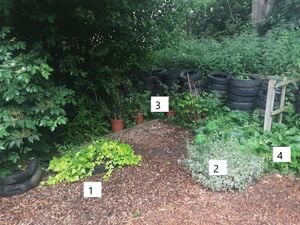
Photographs were taken in Summer 2021 to help future volunteers understand the planting schemes. Unfortunately, identity of several plants was lost as several months passed without access to the garden, and plants had been repeatedly moved while waiting for planting. To identify, wait until fruiting.
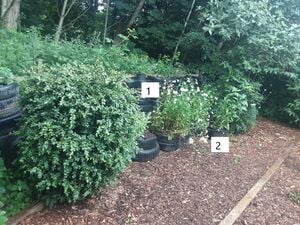
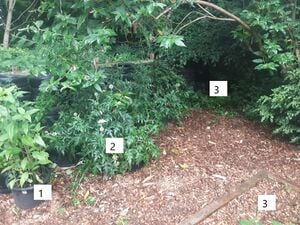
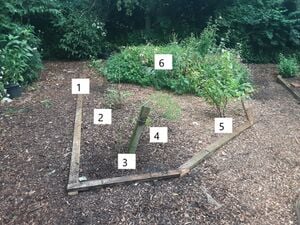
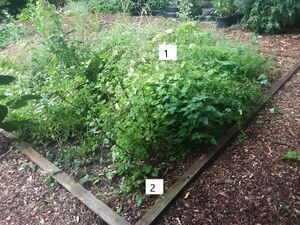
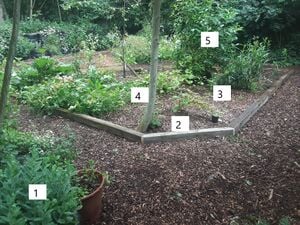
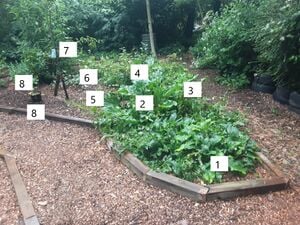
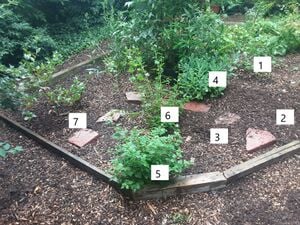
Final works yet to be carried out / ongoing maintenance:
- The NW tyre wall and raised bed could be finished. Once finished, they could provide more planting space.
- Consider adding wires on NW tyrewall in order to train the cane fruits
- Consider continuing tip layering the R. tricolor to gradually act as groundcover for most of the beds.
- Monitor sheet mulch and repair it as required.